美国小学生英语课教案
- 格式:pdf
- 大小:181.80 KB
- 文档页数:11
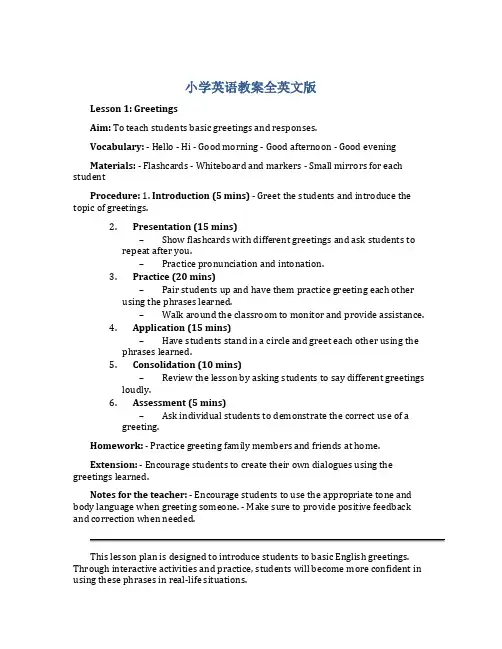
小学英语教案全英文版Lesson 1: GreetingsAim: To teach students basic greetings and responses.Vocabulary: - Hello - Hi - Good morning - Good afternoon - Good eveningMaterials: - Flashcards - Whiteboard and markers - Small mirrors for each studentProcedure: 1. Introduction (5 mins) - Greet the students and introduce the topic of greetings.2.Presentation (15 mins)–Show flashcards with different greetings and ask students to repeat after you.–Practice pronunciation and intonation.3.Practice (20 mins)–Pair students up and have them practice greeting each other using the phrases learned.–Walk around the classroom to monitor and provide assistance.4.Application (15 mins)–Have students stand in a circle and greet each other using the phrases learned.5.Consolidation (10 mins)–Review the lesson by asking students to say different greetings loudly.6.Assessment (5 mins)–Ask individual students to demonstrate the correct use of a greeting.Homework: - Practice greeting family members and friends at home.Extension: - Encourage students to create their own dialogues using the greetings learned.Notes for the teacher: - Encourage students to use the appropriate tone and body language when greeting someone. - Make sure to provide positive feedback and correction when needed.This lesson plan is designed to introduce students to basic English greetings. Through interactive activities and practice, students will become more confident in using these phrases in real-life situations.。
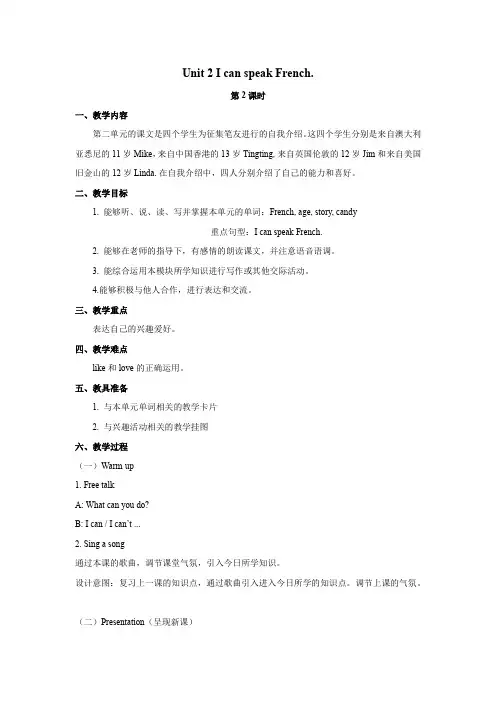
Unit 2 I can speak French.第2课时一、教学内容第二单元的课文是四个学生为征集笔友进行的自我介绍。
这四个学生分别是来自澳大利亚悉尼的11岁Mike,来自中国香港的13岁Tingting,来自英国伦敦的12岁Jim和来自美国旧金山的12岁Linda.在自我介绍中,四人分别介绍了自己的能力和喜好。
二、教学目标1. 能够听、说、读、写并掌握本单元的单词:French, age, story, candy重点句型:I can speak French.2. 能够在老师的指导下,有感情的朗读课文,并注意语音语调。
3. 能综合运用本模块所学知识进行写作或其他交际活动。
4.能够积极与他人合作,进行表达和交流。
三、教学重点表达自己的兴趣爱好。
四、教学难点like和love的正确运用。
五、教具准备1. 与本单元单词相关的教学卡片2. 与兴趣活动相关的教学挂图六、教学过程(一)Warm-up1. Free talkA: What can you do?B: I can / I can’t ...2. Sing a song通过本课的歌曲,调节课堂气氛,引入今日所学知识。
设计意图:复习上一课的知识点,通过歌曲引入进入今日所学的知识点。
调节上课的气氛。
(二)Presentation(呈现新课)1.Listen and say 通过听读活动1的对话,回答问题。
呈现问题,师生互动。
2. Listen and read共听三遍,第一遍时,学生合上课本,听取文章大意;第二遍时,学生着重听他们的兴趣和能力,并进行讨论,第三遍时,学生着重就自身的问题有目的的听录音。
设计意图:通过听读课文,先是整体感知,然后学生能够把握关键信息,能够小组讨论完成对文本的理解,并结合自身的情况,运用所学知识。
3. Key words.(1) 教师呈现相关单词,学生说出基本意思并找出单词在课本中的出处。
(2) 重点单词和短语的讲解。
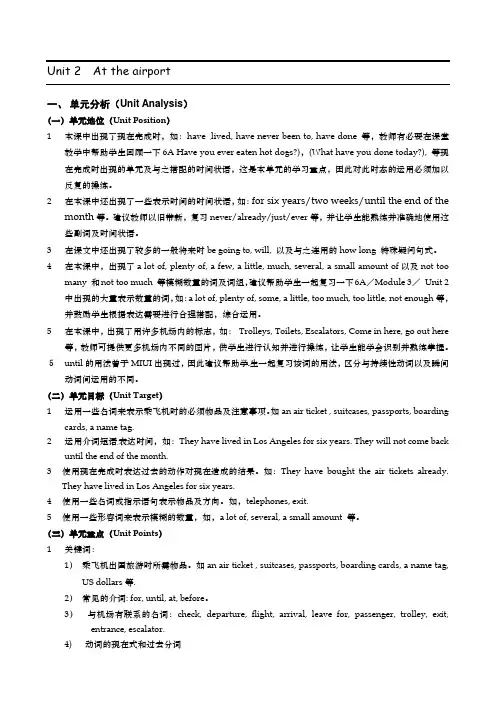
Unit 2 At the airport一、单元分析(Unit Analysis)(一)单元地位(Unit Position)1 本课中出现了现在完成时,如:have lived, have never been to, have done 等,教师有必要在课堂教学中帮助学生回顾一下6A Have you ever eaten hot dogs?),(What have you done today?), 等现在完成时出现的单元及与之搭配的时间状语,这是本单元的学习重点,因此对此时态的运用必须加以反复的操练。
2在本课中还出现了一些表示时间的时间状语,如:for six years/two weeks/until the end of the month等。
建议教师以旧带新,复习never/already/just/ever等,并让学生能熟练并准确地使用这些副词及时间状语。
3在课文中还出现了较多的一般将来时be going to, will, 以及与之连用的how long 特殊疑问句式。
4在本课中,出现了a lot of, plenty of, a few, a little, much, several, a small amount of以及not too many 和not too much 等模糊数量的词及词组,建议帮助学生一起复习一下6A/Module 3/Unit 2中出现的大量表示数量的词,如:a lot of, plenty of, some, a little, too much, too little, not enough等,并鼓励学生根据表达需要进行合理搭配,综合运用。
5在本课中,出现了用许多机场内的标志,如:Trolleys, Toilets, Escalators, Come in here, go out here 等,教师可提供更多机场内不同的图片,供学生进行认知并进行操练,让学生能学会识别并熟练掌握。
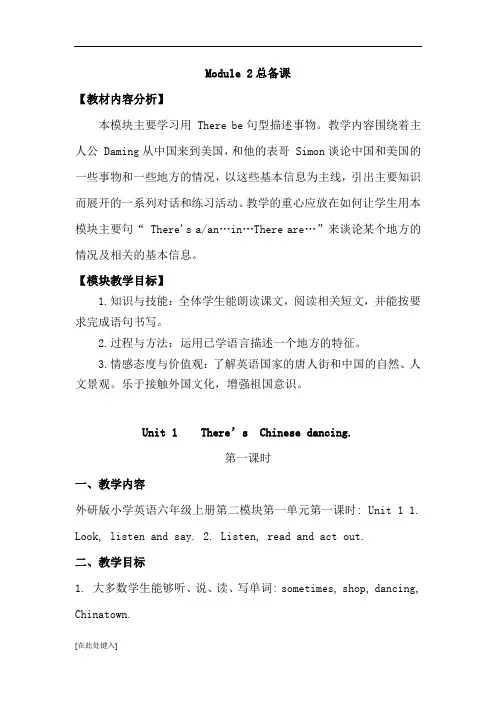
Module 2总备课【教材内容分析】本模块主要学习用 There be句型描述事物。
教学内容围绕着主人公 Daming从中国来到美国,和他的表哥 Simon谈论中国和美国的一些事物和一些地方的情况,以这些基本信息为主线,引出主要知识而展开的一系列对话和练习活动。
教学的重心应放在如何让学生用本模块主要句“ There's a/an…in…There are…”来谈论某个地方的情况及相关的基本信息。
【模块教学目标】1.知识与技能:全体学生能朗读课文,阅读相关短文,并能按要求完成语句书写。
2.过程与方法:运用已学语言描述一个地方的特征。
3.情感态度与价值观:了解英语国家的唐人街和中国的自然、人文景观。
乐于接触外国文化,增强祖国意识。
Unit 1 There’s Chinese dancing.第一课时一、教学内容外研版小学英语六年级上册第二模块第一单元第一课时: Unit 1 1. Look, listen and say. 2. Listen, read and act out.二、教学目标1. 大多数学生能够听、说、读、写单词: sometimes, shop, dancing, Chinatown.2. 大多数学生能够听懂并运用“There’s a Chinatown in New York! There’s Chinese dancing. There are lots of Chinese shops and restaurants there.3. 能够运用所学的语言知识与同伴进行交流。
三、教学重难点(一)重点:1. 听、说、读、写单词: sometimes, shop, dancing, Chinatown.2. 学习句型: There is/are...(二)难点:1. 用句型“There is/am..”描述事物。
2. “You do miss China!”中do表示强调。
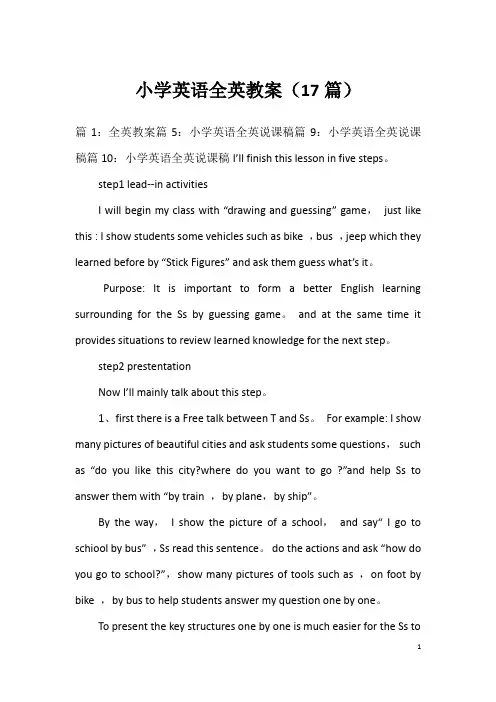
小学英语全英教案(17篇)篇1:全英教案篇5:小学英语全英说课稿篇9:小学英语全英说课稿篇10:小学英语全英说课稿I’ll finish this lesson in five steps。
step1 lead--in activitiesI will begin my class with “drawing and guessing” game,just like this : I show students some vehicles such as bike ,bus ,jeep which they learned before by “Stick Figures” and ask them guess what’s it。
Purpose: It is important to form a better English learning surrounding for the Ss by guessing game。
and at the same time it provides situations to review learned knowledge for the next step。
step2 prestentationNow I’ll mainly talk about this step。
1、first there is a Free talk between T and Ss。
For example: I show many pictures of beautiful cities and ask students some questions,such as “do you like this city?where do you want to go ?”and help Ss to answer them with “by train ,by plane,by ship”。
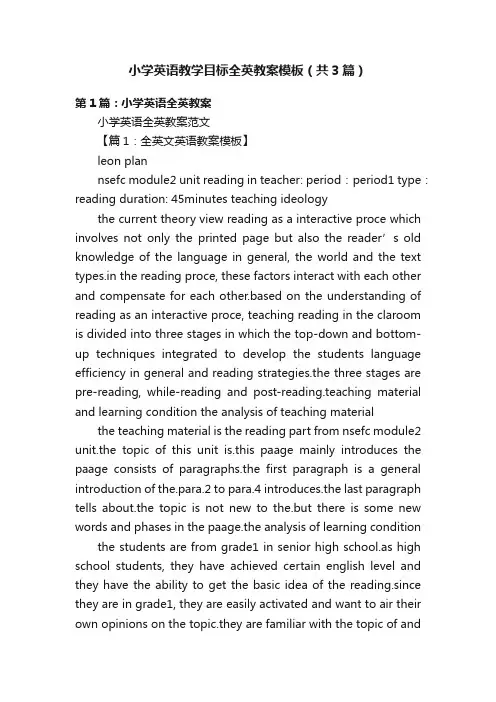
小学英语教学目标全英教案模板(共3篇)第1篇:小学英语全英教案小学英语全英教案范文【篇1:全英文英语教案模板】leon plannsefc module2 unit reading in teacher: period:period1 type:reading duration: 45minutes teaching ideologythe current theory view reading as a interactive proce which involves not only the printed page but also the reader’s old knowledge of the language in general, the world and the text types.in the reading proce, these factors interact with each other and compensate for each other.based on the understanding of reading as an interactive proce, teaching reading in the claroom is divided into three stages in which the top-down and bottom-up techniques integrated to develop the students language efficiency in general and reading strategies.the three stages are pre-reading, while-reading and post-reading.teaching material and learning condition the analysis of teaching material the teaching material is the reading part from nsefc module2 unit.the topic of this unit is.this paage mainly introduces the paage consists of paragraphs.the first paragraph is a general introduction of the.para.2 to para.4 introduces.the last paragraph tells about.the topic is not new to the.but there is some new words and phases in the paage.the analysis of learning condition the students are from grade1 in senior high school.as high school students, they have achieved certain english level and they have the ability to get the basic idea of the reading.since they are in grade1, they are easily activated and want to air their own opinions on the topic.they are familiar with the topic of andknow some.but they may not know before.moreover, their vocabulary is limited so they may have difficulties in understanding some sentences.learning objectives nguage skills ? at the beginning of the cla, can predict the content of the paage based on the title.? can scan the paage and find out the specific information such as the person related withcan summarize the paage with the help of the clues of the nguage knowledgecan master the key words and phrases of the paage as follows,.? can learn , especially 3.affectswill realize that and they will concern themselves with the iue of4.cultural awarenewill broaden their minds by knowing something about 5.learning strategieswill cultivate their ability individual learning and cooperative learning by doing someactivities independently and some in groups.? will communicate with each other in english while doing the group nguage difficultiesfocuses and anticipated language focusesthis is a reading period so the focus is to cultivate the students’ reading skills.the many activities are designed to help to train their reading skills, such as predicting, skimming, scanning and summarizing.it is also important for the to master the new words and phrases.anticipated difficultiesas the have a limited vocabulary, so they may have some difficulties in understanding the paage.so the teacher will help them learn the new words and phrases.may did not heard before, so the teacher will tell them some background knowledge aboutit.teaching methodthree-stage model: based on the understanding of reading as an interactive proce, teaching reading in the claroom is divided into three stages in which the top-down and bottom-up techniques integrated to develop the students language efficiency in general and reading strategies.the three stages are pre-reading, while-reading and post-reading.teaching aids multimedia devices and ppt documents: in order to help to fully understand the whole paage, i adopt multimedia devices and ppt documents to bring the real-life situation into the claroom.teaching procedures step1.lead-in(6min)activity1.greetings and free-talking(2min)t leads into the topic by asking some they know.tell the name of the they know freely.t: hello boys and girls.(say hello to the teacher.)t: when we say , what appears in your minds?(tell the things appear in their minds freely.)t: what are the ?(tell some names of.) activity2.picture-talking(4min)t shows some pictures about the in china and abroad.after seeing the pictures, are expected to tell the similarities of them.t: just now, you talk about some in china.now, let’s see some pictures of some.(t shows the pictures and see them carefully.) t: what do the have in common?for example, they are very precious.what are your opinions?(t gives them some hints and tell the characteristics of)[aims] in this step, t first leads in the topic by talking with the freely about the whichis familiar to them and then see some pictures and tell the characteristics.these two activities aim to arouse the ’ interests in the topic and activate their old knowledge of.then will bementally prepared for the reading comprehension.what’s more,when they are talking about the charateristics of, they will realize that theare rare and precious and they will concern themselves with the iue of.step2.pre-reading(3min)activity1.knowing something about(1min)t gives a brief introduction of the.will know the t: today, we are going to learn.it is.do you know what is?(t shows some pictures ofand get to know the.)activity2.predicting(2min)t asks to read the title of the paage and then ask them some questions.will predict the content of the paage with the help of the title.t: please look at the ti tle “”, what does “” mean?(if the can not give the answer, then t explain it.)t: in search means that people are looking for it.why are people looking for it? can you gue? what will the paage talk about?(predict the content, but t will not give the answer here.)[aims] in this step, the first know some information of the;the background information will make it easier for the to understand the paage.then t asks to make predictions about the paage.it aims to help develop the reading skills of predicting.step3.while-reading(22min)activity1.skimming(4min)skim the whole paage and find out and check their predictions.t: why are people still ? here is a multiple choice for you.activity2.scanning(3min)t presents several true or false statements and asks the to scan the paage and judge the right from the wrong.(keys: F,F,T,T,F)activity3 close-reading(15min)t designs various kinds of activities and do the activities to fully understand the paage.para.1t: please read para.1 carefully and then take some note aboutthe.para.2-4please read para.2-4 carefully and then find out the removal of the room.please read para.2-4 carefully and then find out the person related with the amber room and the things them down with it.para.5 please read para.5 carefully and then find out the the rebuilding of the amber room.【篇2:pep小学英语全英教案模板】the english teaching plan of pep book 4enhe primary school teacher:___________ the curriculum schedule cla:____________ cla:____________ the teaching schedule the students’ result tablethe english curriculum standard英语课程标准一级目标总体目标:对英语有好奇心,喜欢听他人说英语;能根据教师的简单指令做游戏、做动作、做事情(如涂颜色、连线);能做简单的角色扮演;能唱简单的英文歌曲,说简单的英语歌谣;能在图片的帮助下听懂和读懂简单的小故事;能交流简单的个人信息,表达简单的情感和感觉;能书写字母和单词;对英语学习中接触的外国文化习俗感兴趣。
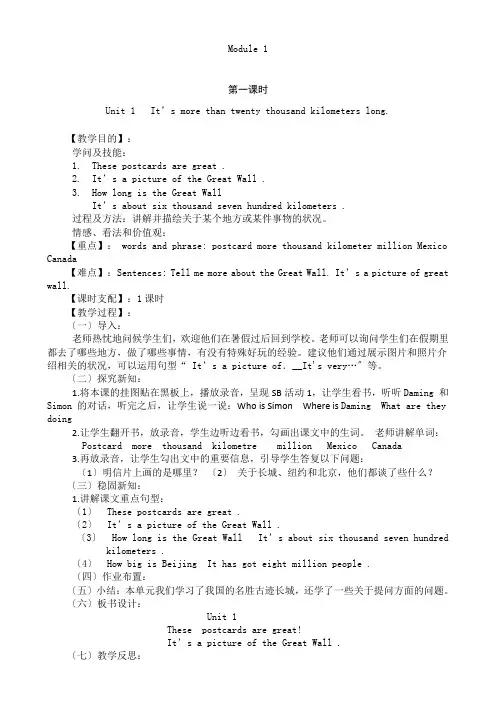
第一课时Unit 1 It’s more than twenty thousand kilometers long.【教学目的】:学问及技能:1. These postcards are great .2. It’s a picture of the Great Wall .3. How long is the Great WallIt’s about six thousand seven hundred kilometers .过程及方法:讲解并描绘关于某个地方或某件事物的状况。
情感、看法和价值观:【重点】: words and phrase: postcard more thousand kilometer million Mexico Canada【难点】:Sentences: Tell me more about the Great Wall. It’s a picture of great wall.【课时支配】:1课时【教学过程】:〔一〕导入:老师热忱地问候学生们,欢迎他们在暑假过后回到学校。
老师可以询问学生们在假期里都去了哪些地方,做了哪些事情,有没有特殊好玩的经验。
建议他们通过展示图片和照片介绍相关的状况,可以运用句型“It’s a picture of.__It's very…〞等。
〔二〕探究新知:1.将本课的挂图贴在黑板上,播放录音,呈现SB活动1,让学生看书,听听Daming 和Simon的对话,听完之后,让学生说一说:Who is Simon Where is Daming What are they doing2.让学生翻开书,放录音,学生边听边看书,勾画出课文中的生词。
老师讲解单词:Postcard more thousand kilometre million Mexico Canada3.再放录音,让学生勾出文中的重要信息,引导学生答复以下问题:〔1〕明信片上画的是哪里?〔2〕关于长城、纽约和北京,他们都谈了些什么?〔三〕稳固新知:1.讲解课文重点句型:〔1〕 These postcards are great .〔2〕It’s a picture of the Great Wall .〔3〕How long is the Great Wall It’s about six thousand seven hundred kilometers .〔4〕 How big is Beijing It has got eight million people .〔四〕作业布置:〔五〕小结:本单元我们学习了我国的名胜古迹长城,还学了一些关于提问方面的问题。
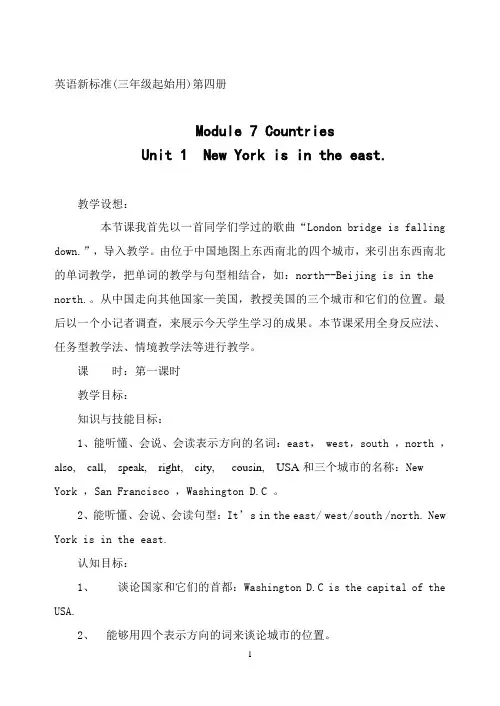
英语新标准(三年级起始用)第四册Module 7 CountriesUnit 1 New York is in the east.教学设想:本节课我首先以一首同学们学过的歌曲“London bridge is falling down.”,导入教学。
由位于中国地图上东西南北的四个城市,来引出东西南北的单词教学,把单词的教学与句型相结合,如:north--Beijing is in the north.。
从中国走向其他国家—美国,教授美国的三个城市和它们的位置。
最后以一个小记者调查,来展示今天学生学习的成果。
本节课采用全身反应法、任务型教学法、情境教学法等进行教学。
课时:第一课时教学目标:知识与技能目标:1、能听懂、会说、会读表示方向的名词:east, west,south ,north,also, call, speak, right, city, cousin, USA和三个城市的名称:New York ,San Francisco ,Washington D.C 。
2、能听懂、会说、会读句型:It’s in the east/ west/south /north. New York is in the east.认知目标:1、谈论国家和它们的首都:Washington D.C is the capital of the USA.2、能够用四个表示方向的词来谈论城市的位置。
情感目标:通过对本课的学习,让学生了解有关美国的一些知识,培养他们跨文化意识和国际视野。
通过引导学生参与游戏、竞争等丰富多彩的教学活动,激发了学生的学习兴趣和积极思维的能力,培养学生的合作精神和竞争意识。
教学重点:1、能听懂、会说、会读词汇:east,west,south ,north, New York,San Francisco,Washington D.C. 。
2、能听懂、会说、会读句型:It’s in the east/ west/south /north. New York is in the east.教学难点:运用学过的单词、句型正确地表述城市的位置。
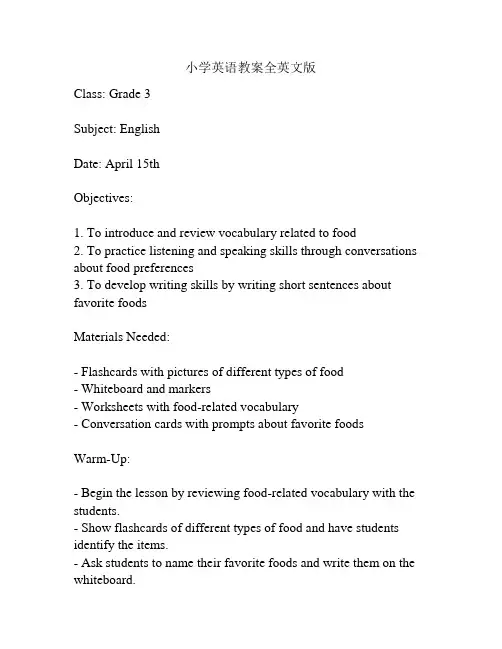
小学英语教案全英文版Class: Grade 3Subject: EnglishDate: April 15thObjectives:1. To introduce and review vocabulary related to food2. To practice listening and speaking skills through conversations about food preferences3. To develop writing skills by writing short sentences about favorite foodsMaterials Needed:- Flashcards with pictures of different types of food- Whiteboard and markers- Worksheets with food-related vocabulary- Conversation cards with prompts about favorite foodsWarm-Up:- Begin the lesson by reviewing food-related vocabulary with the students.- Show flashcards of different types of food and have students identify the items.- Ask students to name their favorite foods and write them on the whiteboard.Lesson Introduction:- Introduce the topic of the lesson, which is about food preferences. - Explain that we will be talking about our favorite foods and why we like them.Activity 1: Listening and Speaking- Divide the class into pairs and give each pair a conversation card with prompts about favorite foods.- Have students take turns asking and answering questions about their favorite foods.- Monitor and provide assistance as needed.Activity 2: Writing- Distribute worksheets with food-related vocabulary to each student.- Ask students to write short sentences about their favorite foods using the vocabulary on the worksheet.- Encourage students to be creative and use descriptive language in their sentences.Closure:- Review the key vocabulary and phrases learned during the lesson. - Have students share their favorite foods and sentences with the class.- Conclude the lesson by reminding students of the importance ofhealthy eating habits.Homework:- Ask students to write a paragraph about their favorite meal at home and why they enjoy it.- Encourage students to include details about the ingredients and flavors of the meal.。
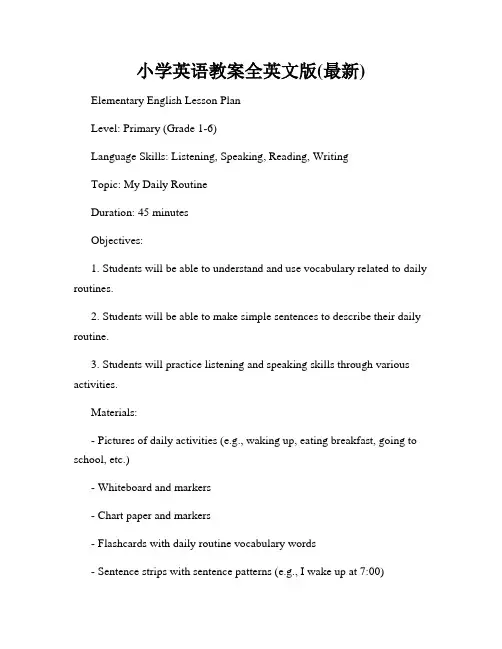
小学英语教案全英文版(最新)Elementary English Lesson PlanLevel: Primary (Grade 1-6)Language Skills: Listening, Speaking, Reading, WritingTopic: My Daily RoutineDuration: 45 minutesObjectives:1. Students will be able to understand and use vocabulary related to daily routines.2. Students will be able to make simple sentences to describe their daily routine.3. Students will practice listening and speaking skills through various activities.Materials:- Pictures of daily activities (e.g., waking up, eating breakfast, going to school, etc.)- Whiteboard and markers- Chart paper and markers- Flashcards with daily routine vocabulary words- Sentence strips with sentence patterns (e.g., I wake up at 7:00)Procedure:Introduction (5 minutes):1. Greet the students and introduce the topic of the lesson: "Today, we are going to learn about our daily routines. What do you do every day? Let's find out!"Presentation (10 minutes):2. Show pictures of different daily activities and elicit vocabulary from the students. Write the words on the whiteboard as they say them.3. Introduce the sentence patterns by writing examples on the whiteboard, such as "I wake up at 7:00" or "I brush my teeth after breakfast." Ask students to repeat the sentences after you.Practice (15 minutes):4. Divide the class into pairs or small groups. Give each group a set of flashcards with daily routine vocabulary words.5. Ask the students to take turns picking a flashcard and making a sentence using the word. For example, if a student picks the "brush teeth" flashcard, they can say, "I brush my teeth before bed." Encourage them to use the correct time phrases (e.g., before, after, in the morning).6. Circulate around the classroom, monitoring the students' progress and providing assistance when needed.Listening Activity (10 minutes):7. Play a recording or read aloud a short passage about a person's daily routine. Provide students with a simple worksheet with multiple-choice questions based on the passage.8. After playing the recording or reading the passage, allow students to work individually or in pairs to answer the questions. Then, review the answers together as a class.Production (10 minutes):9. Ask students to create a poster or a chart showing their daily routines. Provide them with chart paper and markers.10. Encourage students to use the vocabulary and sentence patterns they have learned during the lesson.11. Once the posters are complete, have the students share their charts with the class by presenting them briefly.Wrap-up (5 minutes):12. Review the vocabulary and sentence patterns covered in the lesson. Ask students to share anything new they have learned about their classmates' daily routines.13. Thank the students for their participation and effort during the lesson.Note: Throughout the lesson, make sure to use simple and clear instructions. Provide support and scaffolding as needed, and adapt the activities based on the students' language proficiency level.。
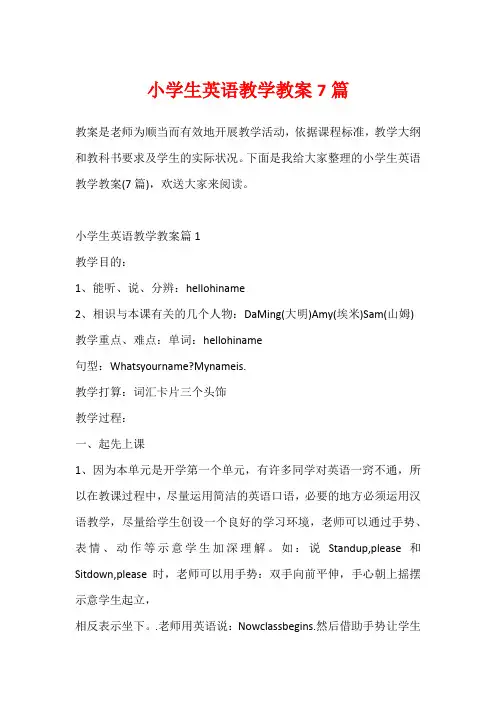
小学生英语教学教案7篇教案是老师为顺当而有效地开展教学活动,依据课程标准,教学大纲和教科书要求及学生的实际状况。
下面是我给大家整理的小学生英语教学教案(7篇),欢送大家来阅读。
小学生英语教学教案篇1教学目的:1、能听、说、分辨:hellohiname2、相识与本课有关的几个人物:DaMing(大明)Amy(埃米)Sam(山姆)教学重点、难点:单词:hellohiname句型:Whatsyourname?Mynameis.教学打算:词汇卡片三个头饰教学过程:一、起先上课1、因为本单元是开学第一个单元,有许多同学对英语一窍不通,所以在教课过程中,尽量运用简洁的英语口语,必要的地方必须运用汉语教学,尽量给学生创设一个良好的学习环境,老师可以通过手势、表情、动作等示意学生加深理解。
如:说Standup,please和Sitdown,please时,老师可以用手势:双手向前平伸,手心朝上摇摆示意学生起立,相反表示坐下。
.老师用英语说:Nowclassbegins.然后借助手势让学生起立,用英语向学生问好。
T:Goodmorning,class!S:Goodmorning,teacher!然后用英语说:Sitdown,please.并同时做出请学生坐下的手势。
老师向学生说明Goodmorning的意思,并告知学生下午好应说“Goodafternoon”。
用手势介绍teacher和class这两个词,然后要全班用一样的语句来应答。
T:Goodmorning,class!Ss:Goodmorning,teacher!T:Goodafternoon,class!Ss:Goodafternoon,teacher!反复训练几次,直到学生练熟为止。
老师可以反复重复:Standup.及Sitdown,please.等用语,让学生们做出相应的动作,直到确信学生已经能听懂为止。
2、老师用英语向学生做自我介绍。
老师告知全班学生:WeregoingtolearnLessonOnetoday.并用中文(今日我们学习第1课)重说一遍,让学生听懂即可,并板书LessonOne在黑板上。
小学英语教案全英文版(优秀13篇)小学英语全英文教案范文篇一Goood moring, Im glad to interpret my lesson here . The lesson plan I am going to talk about is Part A lets learn of unit1 PEP Primary English book7. I will explain how to teach and the reason for doing this from following aspects.Ⅰ analysis of the teaching content.Ⅰ ways of teaching and learning .Ⅰ teaching proceduresⅠ blackboard designV assessmentNow Let;s focus on the analysis of teaching content. It can be divided into 3 parts as followed: the status and the function, the teaching objectives , the main points and difficult points, I;ll talk about it one by one.This lesson is the first lesson of unit 1, book7 . It includes two parts: Let;s learn and let;s play. In section 1, it mainly deals with these key phrases: on foot, by bike, by bus, by train, by subway. And in section 2, it provides a game for the Ss to prastise the patterns: How do you go to? And the answer: I go by../ on foot.Our students have already known some vehicles in the daily life. It;s not difficult for them to understand and use these words . If students can learn it well, it will help students to learn the rest of this unit. So, I set the following aims:The first is language objectivesTo make sure that students can read, recognize and use these key phrases :on foot ,by bike,by bus,by train skillfully.The next is ability objectives(1) To develop Ss; abilities of listening and speaking.(2) To train the Ss; ability of working in groups.moral objectives(1)to help students know some vehicles and comprehend the traffic rules(2) To foster Ss; consciousness of good co-operation and proper competition.The main points and difficult points about this lesson is:(1) To make sure that Ss can use these key phrases correctly and skillfully.(2) To enable Ss to study in groups and co-operate skillfully.(3) To develop Ss; interest in English.Difficult pointsTo help the Ss ask and answer the question “How do you go to?part Ⅰways of teaching and learningAs we all know: the main instructional aims of learning English in primary school is to cultivate pupils; basic abilities of listening and speaking and their good sense of the English language. So in this lesson I;ll mainly use “Task-based” teaching method. That is to say, I will let the Ss learn in real situations, finish a task by making a survey”How do you go to school?” to help Ss to get a better understanding of the key phrases. I will arrange these activities: guessing game, finishing a survey and having a competition. And in this lesson a recorder, CAI, will be needed.partⅠ teaching proceduresI;ll finish this lesson in five steps.step1 lead--in activitiesI will begin my class with drawing and guessing game, just like this : I show students some vehicles such as bike ,bus ,jeep which they learned before by Stick Figures and ask them guess what;s it.Purpose: It is important to form a better English learning surrounding for the Ss by guessing game. and at the same time it provides situations to review learned knowledge for the next step.step2 prestentationNow I;ll mainly talk about this step.1、first there is a Free talk between T and Ss. For example: I show many pictures of beautiful cities and ask students some questions, such as do you like this city?where do you want to go ?and help Ss to answer them with by train ,by plane,by ship.By the way, I show the picture of a school, and say“ I go to schiool by bus” ,Ss read this sentence. do the actions and ask how do you go to school?,show many pictures of tools such as ,on foot by bike ,by bus to help students answer my question one by one.To present the key structures one by one is much easier for the Ss to learn and grasp the meanings.2 With the help of the CAI I set a situation to help Ss understand the way of using these key phrases:A boy is coming, who is going to school. He says: I go to school byThen play the sounds of bus, bike ask students to listen carefully and tell “I go to school by according to the different sounds, by the way , I present another new phrases:by subwayPurpose:Make Ss use these new phrases with sentence structures, to help Ss use the language in a real situation.step3 practise3 I order to make every student read these new phrases correctly, I design a drill in this step,I show cards as soon as possible ,students should read the words quickly and spell them. Then I ask How do you go to school?students answer I go to ......also I will quicken the speed to ask .The purpose is to draw the whole studentsattention to the spelling of the words4 After this, I ask Ss to do Lets play in fours. They use places cards and vehicle cards, ask and answer:How do you go to ? I go to by”5, If Ss can ask and answer expertly, I will ask them to make a short dialogue.the purpose of this is to help students to learn those sentenses through a ture situation and make the dialogues in order to check if Ss can usse these key prases、sentences structures skillfullystep 4 consolidationlet students do a survey about how do you go to school?and the table like this :write down names and tools another Ss chooseTask-based teaching method is used here to develop Ss; ability of ; communication and also their ability of co-operation will be well trained.step 5 homeworkask students to collect other kinds of transport tools through the library ,computer.the purpose of this is to stimulate the interest of learning english and to wide the studentsknowledgestep6 blackboard designmy blackboard design like this :on the left Ishow the phrases:on foot,by bus.......on the right there are many sentences:how do you go to school?I go to ......step 7 assessmentdue to the studentsage ,I make every students work in class through many activities in order to stimulate the studentsinterest and provide they a wide thinking room. I make students learn this lesson very well through desiring scene statuesthats all,thank you for your listening !Unit 1 Lesson 篇二Part A Let;s say, Let;s chant Part C CultureTeaching Aims :1、Be able to listen, say, recognize the words: apple, ant, boy, bag, Coke, coffee.2、Be able to listen, say, read and write these three letters: A a; B b; C c3、Through the chant review the letters of ABC, train a sense of group identity.Focus Points amp; Difficult Points :Read the letters: Big letter C, small letter c; Write down them correctly and handsomely.Teaching Preparation:1、Letter cards ,some word pictures, word cards: apple boy eraser ant crayon body head cake Coke coffee bag ball2、A little blackboard with four-line format and a ball.Designing for the blackboard:panda beaver eagle kangaroo (pictures)China Canada America Australia (words)Teaching Steps:Step1. Warm ndash;up1、Sing a song.2、Free talkT: Hello. I;m Wendy. I;m from Hangzhou.S1: Hello! I;m 。
The Joke’s on You!–Grade One1Ohio StandardsConnection
Phonemic Awareness, Word Recognition and Fluency
Benchmark B Demonstrate fluent oral reading, using sight words and decoding skills, varying intonation and timing as appropriate for text
Indicator 10Read aloud with changes in emphasis, voice, timing and expression that show a recognition of punctuation and an understanding of meaning.
Acquisition of VocabularyBenchmark D Know the meaning of specialized vocabulary by applying knowledge of word parts, relationships and meanings.
Indicator 5Recognize that words can sound alike but have different meanings (e.g. homophones such as hair and hare).
Lesson Summary: During this interactive lesson, students share and create jokes to promote and enhance reading skills (fluency, emphasis, timing and sight word recognition), acquire vocabulary and recognize homophones. Students read their jokes aloud, concentrating on voice characteristics. The culminating project of a class joke bookcontains students’ individually written and illustrated jokes.
Estimated Duration:Two to three weeks. Time spent on each lesson part dependson students’ abilities and needs.
Commentary:Laughter is the best medicine, andstudents have an opportunityto do just that with this lesson. Students strengthen their vocabularyand critical thinking skills as they use resources to createjokes and punch lines. Students present their jokes to classmates and publish them in a class joke book. Enjoyhumor at its first-grade best!
Instructional Tip:This lesson is best suitedfor the second half of the first-grade year.
Pre-Assessment:·Provide familiar humorous leveled text (e.g., story, joke, riddle) for students to read aloud. ·Have students record themselves reading text.·Listen and note students’ abilities to read aloud with changes in emphasis, voice, timing and expression that show a recognition of punctuation.
Scoring Guidelines:Write and use anecdotal notes to document individual students’ fluency—their skill in changing emphasis, voice, timing and expression in recognition of text punctuation.
Post-Assessment:·Students read “homophone jokes”(composed during lesson) to whole class or to small group of students.·Listen and note use of voice, timing, expression and emphasis while readingthat demonstrate students’ recognition and understanding of punctuation in text.·Ask students in small groupsor whole class to listen for and identifythe homophones in the jokes. · The Joke’s on You!–Grade One2·Provide opportunitiesfor students to guess and share answersto jokes.·Have joke tellers respond to ideas and read answers or punch lines for jokes.·Use checklist (Post-Assessment Checklist, Attachment A) to assess individual students’ understanding and skillsor conduct individual writing/reading conferences.
Scoring Guidelines:Use the Post-AssessmentChecklist, Attachment A, to evaluateand comment on students’ readings. Document progress based on students’ abilities to dothe following:·Identifyand define homophones in written text.·Read and tell jokeswith changes in emphasis, voice, timing and expression, based onrecognition of and reaction to text punctuation.
Instructional Procedures:Part One1.Post a short, simple joke containing a pair of homophones (in large or bold font) for students to read. (Refer to this as theJoke of the Day.On a dailybasisfor the duration of the lesson, post newjokes that contain homophones.)
Instructional Tip:“Knock knock” jokes or short jokes that ask questions with one-line responses provide examples for students at this introductorylevel.
2.Read the joke together in a shared reading experience. Following are several examples of simple, age-appropriate jokes with homophones:a.Whydidthe man cross the road?To see a bear that was bare.b.Whydid the boygo to the beach?He wanted to see the sea.c.Knock, knock. Who’s there? Flower. Flower who? A flower made of flour.d.What do you get when you mix a storywith a part of an animal that wags?A tail tale.e.What did the sailor sayto the store clerk? Ihope that sail is on sale.3.Point out the punctuation marks (question marks, periods and exclamation marks) that endthe parts of the jokes.4.Model and explain how punctuation affects the reader’s voice, emphasis on words, timingand expression.5.Re-read the joke with the students. Encourage students to take note of the punctuation and adjust their voices and timing accordingly.
Instructional Tip:Create end punctuation marks on card stock and move them from one line of the joke to another. Have students read the line with the new punctuation mark (e.g., I hope the sale is on sale?What did the sailor sayto the store clerk?).Practice reading with incorrect punctuation marks to emphasize the need forand importance of the correct end punctuation.)